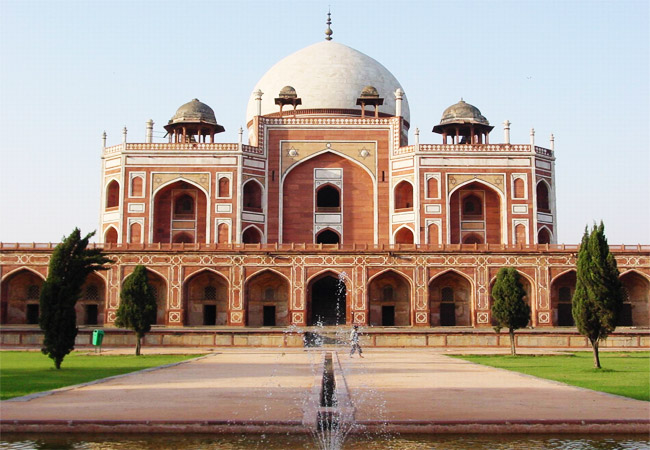




India’s capital, Delhi is the hub of the country: a buzzing international metropolis which draws people from across India and the globe. Home to fifteen million people, it’s big, sprawling and still growing. Yet tucked away inside Delhi’s modern suburbs and developments are tombs, temples and ruins dating back centuries. The result is a city full of fascinating nooks and crannies that you could happily spend weeks, or even months, exploring around modern Delhi saw Lalkot built in the mid-11th century, Siri established by Allauddin Khilji, Tughlakabad, and Ferozabad built by the Tughlaks followed by the city of the Lodis and then came Shahjahanabad, capital of the Mughals under Shah Jahan.
New Delhi reflects the legacy the British left behind, distinction between the capitals of the British and the Mughals respectively. But wherever the visitor goes he will invariably confront the city’s past.
From a tourist’s perspective, Delhi is divided into two main parts. Old Delhi is the city of the Mughals and dates back to the seventeenth century. It’s the capital’s most frenetic quarter, and its most Islamic, a reminder that for more than seven hundred years Delhi was a Muslim-ruled city. Old Delhi’s teeming bazaars have a tale to tell, its greatest monuments are undoubtedly the magnificent constructions of the Mughals, most notably the mighty Red Fort, and the Jama Masjid, India’s largest and most impressive mosque. to the south, encompassing the modern city centre, is New Delhi, built by the British to be the capital of their empire’s key possession. A spacious city of tree-lined boulevards, New Delhi is also impressive in its own way. The Rajpath, stretching from India Gate to the Presidential Palace, is at least as mighty a statement of imperial power as the Red Fort, and it’s among the broad avenues of New Delhi that you’ll find most of the city’s museums, and its prime shopping area, centered around the colonnaded facades of Connaught Place
The divisions in the walled city and New Delhi also mark the varied lifestyles. The walled city is all traditions ,whereas, New Delhi in contrast, is a city living upto contemporary international standards. Delhi also serves as the major gateway for touring the internationally known toursim destinations of Agra and Jaipur.
Some important places worth visiting in Delhi include the Humayun's Tomb, the Jantar Mantar, the Bahai temple, the Qutab Minar, Jama Masjid, Red Fort, Raj Ghat, India Gate. Delhi is also a great shopping destination -- be it the road side stalls of Connaught Place, or the International style swanky shopping malls in the suburbs, shopping is a major attraction for visitors to Delhi. Modern Delhi, now boasts of some world class restaurants, bars and nightclubs.

By Air – Delhi is India's second busiest International airport. Almost all major International airlines operate direct flights to and fro Delhi. In addition, a number of major domestic airlines also use Delhi airport as their hub, connecting it with virtually the length and breadth of India.
By Rail - Delhi is connected by super fast trains to almost all major cities of India.
By Road - Delhi serves as the Gateway to all other tourist destinations in North India, including Agra (220 kms), Jaipur (250 kms), Chandigarh (265 kms) etc.
As the city expands, many shops, restaurants and other businesses are moving into South Delhi, the vast area beyond the colonial city. Here, among the modern developments is where you’ll find some of Delhi’s most ancient and fascinating attractions. At opposite ends of Lodi Road, for example, lie the constructions marking two ends of the great tradition of Mughal garden tombs:Humayun’s Tomb, its genesis, and Safdarjang’s Tomb, its last gasp. Here too, you’ll find the remains of the six cities that preceded Old Delhi, most notably the Qutb Minar and the rambling ruins of Tughluqabad. Beyond the city limits, the NCR (National Capital Region – greater Delhi, in other words) is growing fast, and satellite cities such as Gurgaon and Noida, which are outside the Capital Territory (Delhi proper), are becoming important IT hubs with stunningly modern high-rise office blocks and burgeoning drinking and nightlife scenes.
As a place to hit India for the first time, Delhi isn’t a bad choice, and there’s no shortage of things to see and do while you acclimatize yourself to the Subcontinent. Quite apart from its historical treasures, the city has a host of museums and art treasures, cultural performances and crafts that showcase the country’s diverse heritage. Its growing nightlife scene boasts designer bars, chic cafés and decent clubs. And – particularly useful if it’s from Delhi that you’re flying home – you’ll find you can buy goods here from pretty much anywhere else in India, so it’s a good place to stock up with souvenirs and presents.

